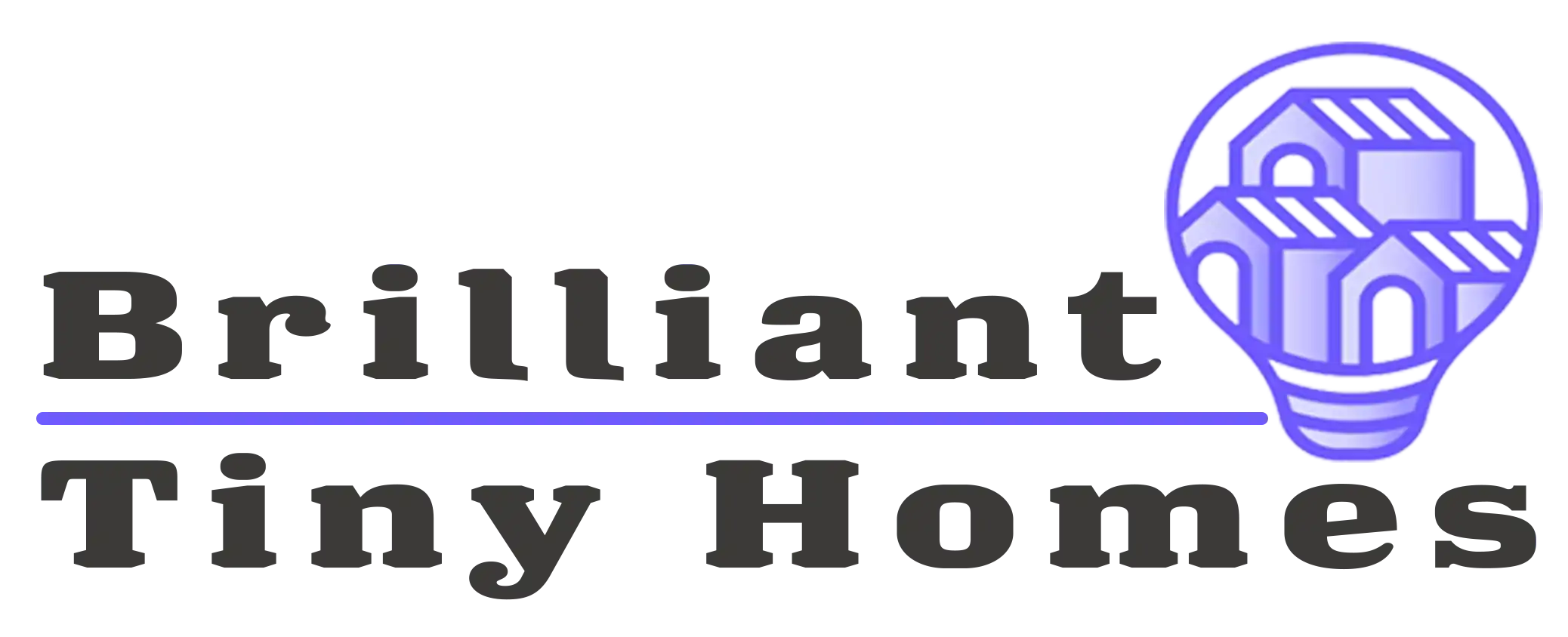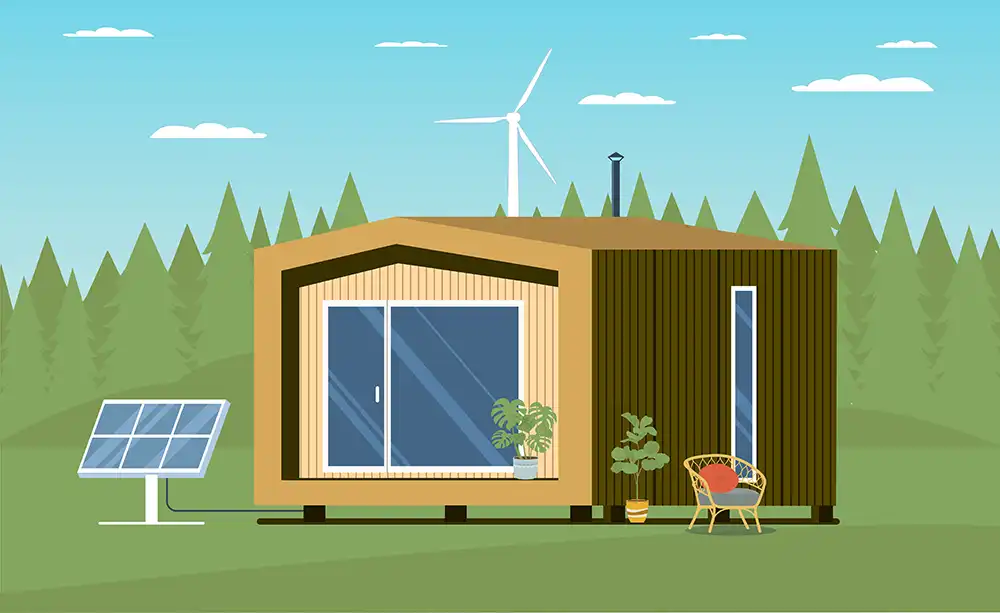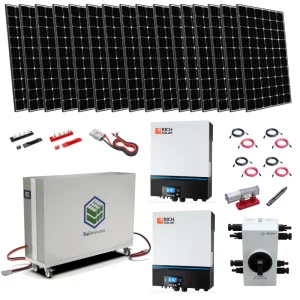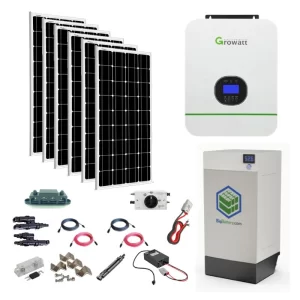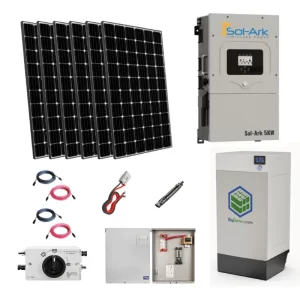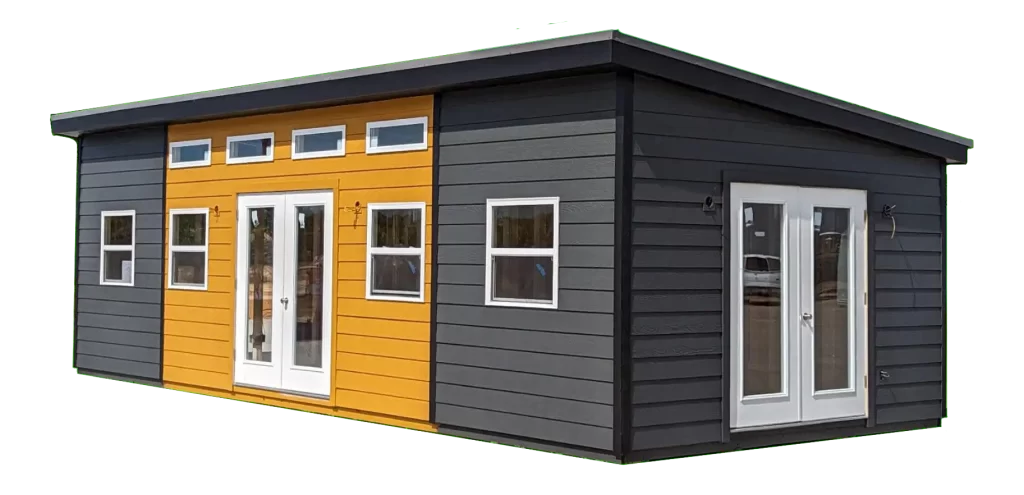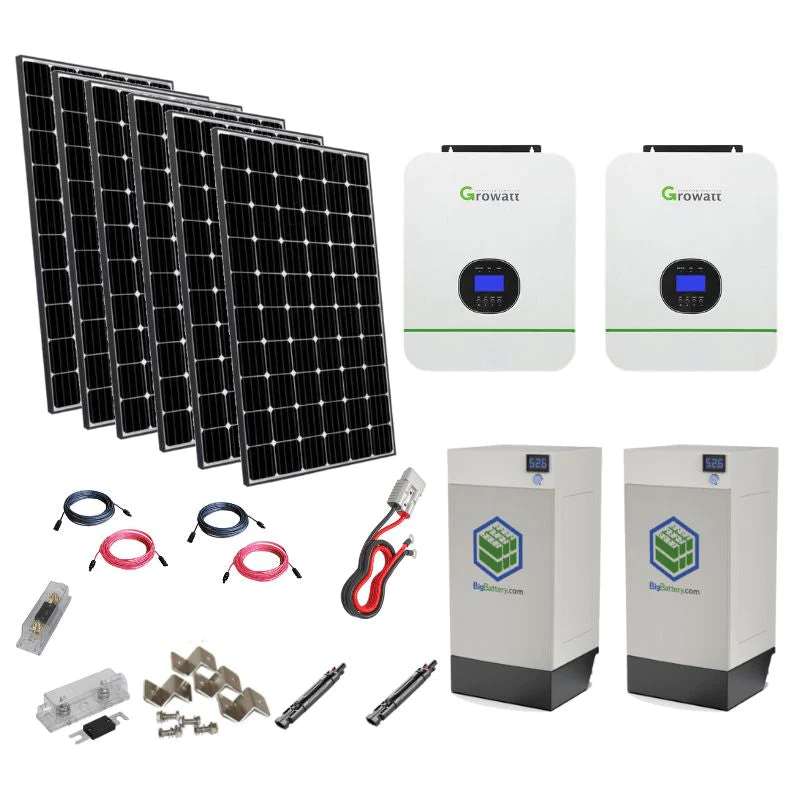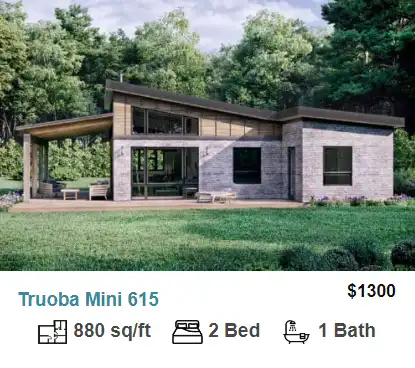Whether it be freedom from utility companies, cost savings, or a desire to take better care of our earth, there are many reasons to consider wind and solar power options for your tiny home.
A well planned solar and wind power system can easily provide enough power for a tiny home with very minimal grid or generator fallback. While solar panels can be used almost anywhere, some locations would require towers so tall that a wind turbine would be impractical.
Solar Power Options for Tiny Homes
When planning a solar power system for your tiny home, there are a few important decisions to make. It is important to decide whether you will have battery storage, buy from and sell back to the grid, or connect to the grid but have a battery backup. Solar power systems can be purchased as all-inclusive kits, pieced together a-la-carte, or installed by a solar power system specialist.
A system that relies on batteries as the sole method of storing electricity, also known as an off-grid system, may be the only option depending on your location. The upfront costs and complexities of an off-grid system may pale in comparison to those of extending power lines through rough terrain. Even for those with access to grid power, opting not to connect may be a totally appropriate option. An off-grid system is unparalleled if your focus is self-reliance.
Off-grid
Pros:
- You will never have a power bill.
- This is sometimes the only solution for locations without existing grid service.
- Off-grid systems are not affected by power company blackouts.
- Off-grid systems can be purchased as complete kits and installed by homeowner
- Readily available off-grid kits are often self-contained except for the solar panels which greatly simplifies the system
Cons:
- There is more expensive equipment, such as the batteries themselves, to buy upfront.
- Building a complete off-grid system from scratch is complex and expensive components can be ruined if mismatched
- The batteries and additional equipment require enclosed storage.
- There is no option to monetize surplus power.
- On-call power is finite and lifestyle sacrifices may have to be made.
- The system must be large enough to supply 100% of your electricity.
- It is prudent, though not required to also buy and install a backup generator.
Solar power systems need not employ large storage batteries. The majority of solar homes in the US freely exchange power back and forth with the grid. These systems are known as grid-tied systems. While not available in all areas, most utility companies will set your account up to charge you for the electricity you use, but also credit you back for supplying your surplus power to the grid.
Grid-tied
Pros:
- Excess power generated can be sold to the power company.
- There is less equipment to buy upfront.
- These systems are simpler with fewer components to maintain.
- There are no bulky batteries to house.
- It is not necessary to supply 100% of your needed electricity. A smaller system can be used as an offset to grid power usage.
- There is nearly unlimited power available at all times via the grid.
Cons:
- Electricity prices are subject to the whims of the market and utility companies.
- When the grid is down, these systems are limited to what the solar panels can produce on demand.
- Gird power and grid power with solar exchange programs are not available in all areas.
- Grid-tied systems need to be installed by a professional adding substantial upfront cost
Hybrid Systems
Hybrid systems offer the ultimate flexibility in a solar power system. These systems are tied into the grid but also rely on batteries for storing various amounts of power. These systems give you most of the advantages of both off-grid and grid-tied systems with the tradeoff of requiring the most equipment and complexity. Upfront costs can be mitigated by starting with a smaller offset system then gradually upgrading solar collection and storage capacity over time. They also have the added benefit of being able to feed additional power to the grid when compared to a grid-only solution.
Our Picks for Solar Power Kits
A complete solar power kit can save you a ton of frustration over trying to piece together a system yourself. Despite my experience with off-grid power systems, I almost always opt to install a kit of matched components rather than risk system failure or worse down the road. Here are my top picks for complete tiny home solar power systems:
Best Kit for High Power Usage: Complete Off-Grid Solar Kit – 13,000W 120/240V Output / 48VDC [28Kwh Lithium Battery Bank] 10-Year Warranty + 6,750 Watts of Solar [OGK-PRO]
This kit, while expensive, is the best complete solar power solution on the market. There is ample power for high-drain appliances like stoves, dryers, and instant hot water heaters so you don’t have to sacrifice comfort for renewable power.
Best Kit for Low to Moderate Power Usage: Complete Off-Grid Solar Kit – 3,000W / 120V / 48VDC [5.3Kwh LiFePO4 Battery Bank] 10-Year Warranty + 1200 Watts of Solar | [HBK-MAX]
This kit is great for those who only need limited power or who intend to use propane or gas for high-drain functions like heating and cooking.
Best Kit for Hybrid Solar Systems: Complete Hybrid Solar Kit – Sol-Ark 5K 120/240V Output + [5.3kwh-10.6kwh Lithium Powerwall] + 2,190 Watts of Solar | 10-Year Warranty [WHK-PLUS]
This kit comes with everything you need to install your own hybrid solar system. The bespoke system monitor minimizes utility grid dependence and optimizes the balance between battery storage and renewable energy sources.
Components of a Solar Power System
Solar Panels
This is the part of the set-up that we all recognize. Solar panels, also known as photovoltaic panels, are the number one factor in determining your system’s overall output potential. Each solar panel consists of a grid of solar cells. Multiple solar panels are often combined, forming a solar array. Solar panels can be mounted on your roof or ground-mounted. They are tilted at an optional angle to absorb as much sunlight as possible throughout the day and some ground-mounted systems even tilt and rotate to track the sun throughout the day. Solar panels can be made using different materials, with silicone wafer type panels making up the bulk of panels currently produced. Monocrystalline panels are currently the industry standard material for most new solar panel installations.
Disconnects
A power disconnect is the switch that controls your system. The system disconnect allows you to cut off the power output from your solar array. These are essential for repairs and solar panel maintenance. They are also necessary if an electrical component becomes damaged, to protect the system from overload damage.
Inverters
Solar inverters are another crucial element of any solar energy system. The inverter’s critical job is to convert Direct Current (DC) electricity produced by the solar panels into Alternating Current (AC) electricity. This conversion is necessary unless your goal is to furnish your home with only DC appliances. For more information on DC appliances, check out our in-depth look here. The inverter is an essential and hardworking piece of solar equipment for those wishing to use standard appliances in their home.
Your power inverter works continuously when you are using electricity and typically only has a lifespan about 1/3 that of your solar panels. It is the most likely part of the entire system to fail. For these reasons it is best to invest in a high quality inverter from the start. It is wise to keep a backup inverter on hand as large inverters aren’t typically easy to source locally in the event of a failure.
Power Meter
Considered optional by some, a power system meter allows you to monitor how much power your solar panels supply at any given time. Power meters are essential equipment for troubleshooting your system and optimizing it for peak performance.
Batteries
Solar batteries are a primary component in off-grid and hybrid solar power systems. Solar batteries perform the same function as any other battery. They store power for later use. Solar batteries store excess power when receiving high amounts of sunlight for use at night and during times of low sunlight. If your energy storage needs are large, multiple batteries can be combined to form a battery bank. Batteries can be one of the most expensive components in a solar power system.
There are several battery options available within the solar power industry—the two main battery chemistries are lead-acid and lithium. You can use flooded lead-acid batteries or sealed AGM batteries within the lead-acid category. If you opt to piece together your own system, be sure to check out this article on batteries for solar power systems.
Charge Controller
A charge controller manages the electrical current from your solar panels to your battery. Charge controllers are useful for limiting the flow of electricity to the optimum level for longevity of your batteries. There are two main types of charge controllers that you are likely to encounter, maximum power point tracking (MPPT) and pulse width modulation (PWM).
Backup
A system backup may or may not be necessary for those with a reliable grid connection but are essential for those with off-grid systems. If your system has battery storage, that is essentially your first line of backup. Once all stored power has been depleted, those with gas powered generators will still be able to produce and consume power, albeit at a higher cost.
Wind Power Options for Tiny Homes
If you live in an area with weather patterns or geographic features that naturally produce a lot of wind, wind power can be the most economical source of electricity available. While the ideal wind power system can potentially supply 90% of your power needs, practical reliability concerns dictate that you should only count on about 50% maximum in real world applications. Potential buyers of home wind turbines should first estimate their site’s wind resource and research potential neighborhood zoning issues. Some height restriction ordinances can interfere with turbine tower installation. You’ll also need to find out if small wind electric systems are even allowed in your area. Here a few rules of thumb when deciding if wind turbines are practical for your site.
- Your site has an adequate wind resource.
- Your home is located on at least one acre of land.
- Your local zoning codes permit wind turbines and tall structures.
- You’re aware of and comfortable with the fact that it will take a long time for dollars saved in power to equal the upfront investment.
- You have strong reasons to forgo or supplement grid power.
Components of Wind Power Systems
Home wind power systems use many of the same components of solar power systems and they can even share components in a wind/solar hybrid setup. While there are few contractors who specialize solely in home wind power systems, there are many kits and individual components available.
Turbine
Home wind turbines come in two main configurations: vertical axis and horizontal axis. Horizontal axis turbines are by far the most commonly used configuration. These turbines look similar to what you have seen on the giant wind farms, but on a much smaller scale. They typically have two to four fiberglass blades that spin on the face of the generator housing. They also have a tail that is responsible for keeping the turbine facing the wind.
Vertical axis turbines can be broadly grouped into two main types: Savonius and Darrieus. Darrieus turbines are ovular in shape with vertical fins running top to bottom. Savonius turbines have a distinctive “S” shape when viewed from above.
There are many innovative projects currently trying to overcome the limitations of vertical axis turbines, but currently horizontal axis turbines are recommended for almost all home applications.
Tower
The turbine tower is a vital structure in most home wind power set-ups. Necessary tower height varies wildly based on local weather patterns, however very few locations are capable of producing significant wind generated power at ground level.
Inverter
As with solar power systems, an inverter is required to convert DC electricity to AC electricity unless you are prepared to invest in strictly DC powered appliances. Inverters tend to be the weakest point of the system. It is wise to buy a high quality inverter to install and a second, identical inverter to keep as an emergency replacement.
Power Meter
Power meters are not strictly necessary, but are invaluable at monitoring your system output for troubleshooting and optimization.
Batteries
Batteries are even more crucial with wind power systems as they are with solar. After all in most locations the sun is more reliable that the wind making power storage crucial.
There are several battery options available within the solar power industry—the two main battery chemistries are lead-acid and lithium. You can use flooded lead-acid batteries or sealed AGM batteries within the lead-acid category. For more information on battery types and their pros and cons, check out this article.
Charge Controllers
While not absolutely required, charge controllers allow you to limit the flow of electricity from your turbine to your batteries for optimal battery longevity.
Backup
When looking at a hybrid system consisting of solar, wind, and grid power, it is hard to imagine needing another backup. For those depending only on wind or wind/solar with no grid tie in, a gas powered generator is necessary equipment.
Our Picks for Wind Turbines
Wind power generation is typically used in conjunction with solar. For this reason, there are few if any complete wind power systems. Your best bet is to add a turbine and tower to one of our recommended complete solar kits above.
Best Budget Wind Turbine: PIKASOLA Wind Turbine Generator 12V 400W with a 30A Hybrid Charge Controller.
This is a great little turbine to dip your toes into wind power generation or add several to really supplement your power production.
Best Overall Wind Turbine: ZHIHUASMTBX 12000W No Noise Vertical Axis Wind Turbine Generator,220V 12V 24V 48V Magnetic Levitation Wind Turbine with MPPT Controller
This super versatile turbine is built to last and is capable of generating enough power to become a cornerstone of your renewable energy system.
Alternative energy power systems are a great investment for your tiny home both in terms of reducing our impact on the planet and saving money on energy over the long term.
Go forth with your knowledge and dare to live tiny.
